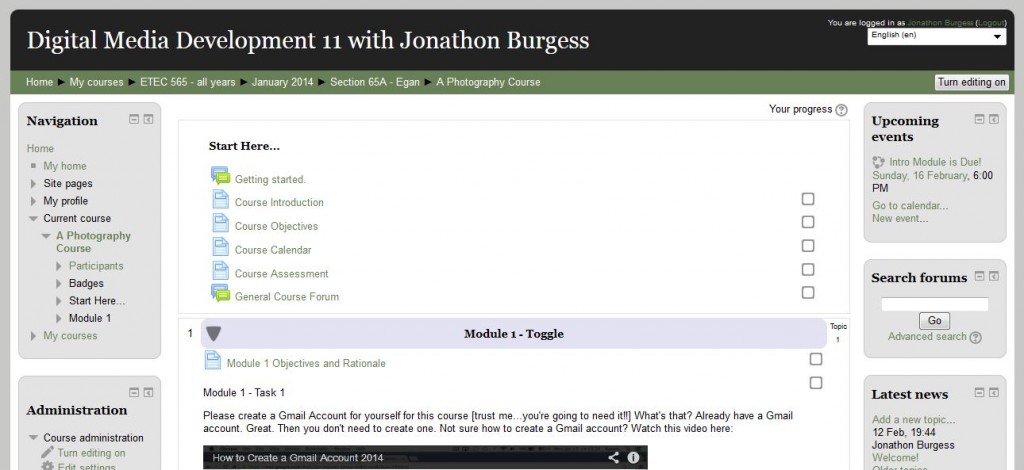I have completed the Introductory Moodle Project which has been a great eye-opener. I approached my design keeping the ideas of Dan Meyer (2010) and Mishra Koehler (2006) (specifically TPCK = technological pedagogical content knowledge) close to heart, and the words of Anderson (2008) as well as Scardamalia and Bereiter (1994) close to mind. I specifically respect the constructivist ideas put forth by Scardamalia and Bereiter, who focus on knowledge-building communities, which they report as having three key characteristics:
(a) focus on problems and depth of understanding;
(b) decentralized, open knowledge environments for collective understanding; and
(c) productive interaction within broadly conceived knowledge-building communities.
(Scardamalia and Bereiter, 1994).
These ideals blend into the ideas of Anderson, who also promotes the ideas of “community-centred” learning, in addition to learning being: “student-centred, assessment-centred, and content-centred”. This first Module attempts to really put the student first. I wanted students to have a chance to share images of what is important in their world, and through images create dialogue and build community. I believe that images are powerful connectors for people. Images can be used to show one’s personality and character; their likes and dislikes. Through this “lens” I hope that students will begin to forge relationships with one another (and with me their instructor).
This first Module also allows students to showcase skills, or further develop skills with technology, pushing them to prove that they have many digital / Web 2.0 skills, including:
- able to use web browsers effectively to find specific content
- able to capture images from a camera and download onto their computer
- able to upload images to a public space
- able to share images effectively through hypertext links
While these e-skills are necessary to be successful in Module 1, and are part of my TPCK design, I chose not to assess students on their technological capabilities; rather, assessment was on the quality (and to an extent quantity) of what they chose to share and how they chose to interact with our community. This was done intentionally so that students would have time to explore the course LMS design as well as build connections to others to enhance their comfort level with the course and with each other (ie. begin the community-building part of learning).
From a technical standpoint, I spent a good deal of time learning to create and edit content in Moodle, including some specific layout design tricks, such as adding horizontal lines using HTML (“<hr>”) and how to get text to go beside an image on a page (ie. put image into a table with two columns, one row, and make table lines white to match background of page). I am very new to Moodle (this is the second time I have seen Moodle in my life) and was proud that I was able to upload images, embed YouTube videos, format text, link externally to various websites, and even include an exemplar of one of the tasks in my Module 1; a Flickr presentation.
Overall I found the Moodle Site to be quite user friendly. I learned very quickly that Firefox is the browser one should use when editing Moodle, as Google Chrome refuses to show tools at times (loading pages too fast??) and Internet Explorer, well, just stinks for just about everything across the Internet. The site did crash about 3 times during development this week, but simply signing out and then back in again was sufficient to “reboot” the system and I never lost any content in the process. There are a number of valuable YouTube videos which helped me perform some of the specific tasks which I wanted to incorporate into my site. I still have loads of questions, such as “What are ‘badges’?” and also am curious about hosting space on a server to accomodate Moodle, copyright and licensing factors, and more.
I know that we will continue to use Moodle as we move through ETEC 565A and I am looking forward to seeing what others have created for their introductions,
Mel Burgess.
Anderson, T. (2008). Towards a theory of online learning. Theory and practice of online learning,, 45-74.
Dan Meyer. (2010). Math class needs a makeover – YouTube. Retrieved February 16, 2014, from https://www.youtube.com/watch?v=NWUFjb8w9Ps.
Mishra, P., & Koehler, M. (2006). Technological pedagogical content knowledge: A framework for teacher knowledge. The Teachers College Record, 108(6), 1017-1054.
Scardamalia, M., & Bereiter, C. (1994). Computer support for knowledge-building communities. The journal of the learning sciences, 3(3), 265-283.

